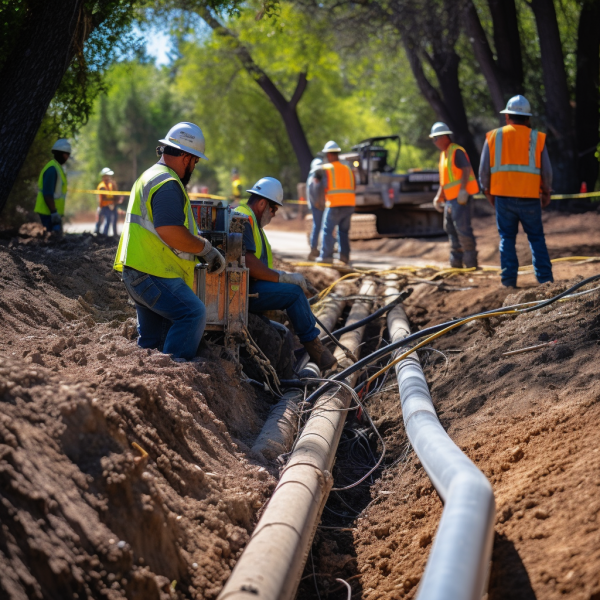PG&E monthly bills might hop higher due to power line burials

Consumer group says insulation could be as safe, less expensive
OAKLAND — PG&E bills could go up if the utility receives state approval for a rate proposal that includes broad plans to bury power lines to help prevent catastrophic wildfires.
A hearing officer with the state Public Utilities Commission is expected to issue a proposed decision on PG&E’s general rate request in the coming days, which could have a variety of effects on monthly customer bills. Among the proposals is one that would require PG&E customers to foot the bill for burying power lines.
This could put a strain on those who have already seen their monthly bills rise due to natural gas prices skyrocketing this winter, according to Mark Toney, executive director of The Utility Reform Network, or TURN, a consumer group.
The PUC hearing officer’s proposed decision will kick off a period in which consumer advocates, PG&E, and other parties can comment on the administrative law judge’s recommendation before the commission’s five members make a final decision.The full state commission is expected to make a decision on the rate case by the end of the year.
“We have a real affordability crisis when it comes to utility costs,” Toney said. “One of the biggest cost drivers is this massive expense for burying 10,000 miles of PG&E power lines.”
Following a series of deadly wildfires in recent years, PG&E’s power lines have come under intense scrutiny.
The deadly fires included blazes in Amador County in 2015, the North Bay Wine Country in 2017, and Butte County in 2018. The fires were started when PG&E equipment came into contact with nearby trees or other vegetation. The infernos erupted in the years following a fatal PG&E gas pipeline explosion in San Bruno in 2010, which killed eight people.
TURN is urging the Oakland-based utility to insulate its lines rather than bury them to reduce fire risk. Toney estimated that overhead line insulation would cost around $800,000 per mile. Burying 10,000 miles of power lines would cost several times as much, he added.
“Insulated lines are completed much faster than buried lines and at a fraction of the cost,” Toney explained. “You are not going to wait 10 to 20 years for the safety you require.” You’ll be there in a few years.”
The cost of burying power lines, according to the utility, was $3.3 million per mile in 2022 and is expected to gradually decrease to around $2.8 million per mile in 2026.
However, PG&E executives believe that burying power lines is the best long-term solution, according to company spokesperson Jennifer Robison.
“Undergrounding electric distribution lines in high fire-risk areas is the most effective long-term solution for keeping customers and communities safe,” said Robison in a statement.”Undergrounding eliminates nearly all of the risk of wildfire ignition from those lines and helps to reduce long-term costs.”
To the south, Southern California Edison, the primary electricity provider in sprawling Los Angeles County and surrounding areas, is taking a more cost-effective approach, committing to insulate 8,000 miles of overhead power lines.
“A covered conductor is an essential tool for quickly mitigating the threat of wildfires caused by debris blowing into power lines.” “It helps keep our communities safe,” Edison CEO Steve Powell said in a statement last summer.
Edison executives estimate that covering approximately 8,000 miles of overhead lines with insulation will cost around $5 billion. Current estimates for burying 10,000 miles of PG&E power lines range from $15 million to $30 billion.
“Undergrounding reduces the need for tree trimming and removal, as well as other wildfire mitigation activities,” PG&E explained. “Undergrounding lines improves long-term reliability and resiliency.”
PG&E claims that its approach reduces the likelihood of weather-related and wildfire safety outages, as well as the risk of damage to overhead power lines.
If PG&E’s proposal is approved, it will almost certainly result in higher customer bills. It comes at a time when monthly bills for residential customers have skyrocketed in recent years. Bills have risen in part due to rising gas and energy costs, as well as system upgrades and wildfire mitigation.
In March 2018, the average monthly bill for a typical residential customer who received electricity and gas services from PG&E was $169.73. In January 2023, the average combined bill was $240.73 per month, indicating that PG&E monthly bills had increased by nearly 42%, or 8.4% on an annual basis.
The overall Bay Area inflation rate, as measured by the consumer price index, has increased by 18.9% in five years, or 3.8% per year on average. In other words, PG&E bills have risen more than twice as fast as the Bay Area’s overall inflation rate.
Toney believes that the PG&E power line burial program has a higher profit potential than the less expensive insulation option, and that it will ultimately help line the pockets of wealthy Wall Street investors.
“PG&E’s underground power line scheme,” Toney said, “is the most expensive and costly method of addressing this challenge.”





